Abstract
The new zygocercous cercaria is described from an intertidal prosobranch gastropod, Clypeomorus batillariaeformis Habe & Kosuge, collected at Heron Island (Great Barrier Reef, Australia). It is of the opisthorchioid type with its oral sucker modified into a penetration organ, eye-spots, seven pairs of prevesicular penetration glands, an oval or rounded epithelial excretory bladder, and a large pigmented tail with dorsal proximal finfold and slender distal portion. Cercariae form large aggregates of up to 700 individuals that swim as one. These assemble in the mantle cavity and escape through the exhalant siphon of the snail. Large aggregates are elongate and hollow, and the cercariae are arranged in a tight spiral at the periphery. The swimming of clusters is performed by simultaneous rotation of the free proximal part of the tails of the cercariae. Aggregates are photopositive. Attempts to infect several species of fish proved unsuccessful. The present account is the eleventh description of a new zygocercous cercaria and the fourth among opisthorchioid trematodes.
Similar content being viewed by others
References
Becker, K. & Kemper, H. (1964) Der Rattenkönig. Eine monographische Studie. Zeitschrift für Angewandte Zoologie, 2, 1–99.
Brumpt, E. (1936) Précis de parasitologie. 1st edition. Paris: 563 pp.
Cable, R.M. (1956) Marine cercariae of Puerto Rico. Scientific Survey of Porto Rico and the Virgin Islands, 16, 491–577.
Cable, R.M. (1963) Marine cercariae from Curaçao and Jamaica. Zeitschrift für Parasitenkunde, 23, 429–469.
Cable, R.M. & McLean, R.A. (1943) The occurrence of Cercaria clausii Monticelli, a marine Rattenkönig larval trematode, on the west coast of Florida. Notulae Naturae, 129, 1–7.
Cable, R.M., Connor, R.S. & Balling, J.W. (1960) Digenetic trematodes of Puerto Rican shore birds. Scientific Survey of Porto Rico and the Virgin Islands, 17, 187–254.
Cannon, L.R.G. (1978) Marine cercariae from the gastropod Cerithium moniliferum Kiener at Heron Island, Great Barrier Reef. Proceedings of the Royal Society of Queensland, 89, 45–57.
Claus, C. (1880) deGrundzüge der Zoologie. 4th edition, Marburg: Elwert'sche Universitats Buchandlung, 821 pp.
Combes, C. (1968) Biologie, écologie des cycles et biogéographie de Digènes et Monogènes d'Amphibiens dans l'Est des Pyrénées. Mémoires du Muséum National d'Histoire Naturelle, Série A, Zoologie, 51, 1–195, 10 pls.
Combes, C. (1980) Les mécanismes de recrutement chez les métazoaires parasites et leur interprétation en termes de stratégies démographiques. Vie et Milieu, 30, 55–63.
Dronen, N.O. (1973) Studies on the macrocercous cercariae of the Douglas Lake, Michigan area. Transactions of the American Microscopical Society, 92, 641–648.
Hancock, J. & Kushlan, J. (1984) The herons handbook. 1st edition. Beckenham: Croom Helm, 288 pp.
Hendrickson, G.L. & Kingston, N. (1974) Cercaria laramiensis sp. n., a freshwater zygocercous cercaria from Physa gyrina Say, with a discussion of cercarial aggregation. Journal of Parasitology, 60, 777–781.
Houbrick, R.S. (1985) Genus Clypeomorus Jousseaume (Cerithiidae: Prosobranchia). Smithsonian Contributions to Zoology, 403, 1–131.
Komiya, Y. (1941) A new “Zygocercaria”, Cercaria radiata, and its excretory system. Journal of the Shanghai Science Institute, new series, 1, 229–232, 2 pls.
Martin, W.E. (1968) Cercaria gorgonocephala Ward, 1916, a zygocercous species in northwestern United States. Transactions of the American Microscopical Society, 87, 472–476.
Martin, W.E. (1971) Larval stages of renicolid trematodes. Transactions of the American Microscopical Society, 90, 188–194.
Martin, W.E. & Gregory, V.L. (1951) Cercaria buchanani n. sp., an aggregating marine trematode. Transactions of the American Microscopical Society, 70, 359–362.
McCauley, J.E. & Pratt, I. (1960) The life history of Echinochasmus milvi Yamaguti, 1939. Journal of Parasitology, 46, section 2, 15.
Miller, H.M. (1929) Continuation of study on behavior and reactions of marine cercariae from Tortugas. Papers from the Tortugas Laboratory, Carnegie Institution of Washington, 28, 292–294.
Miller, H.M. (1930) Formation and behavior of aggregations of cercariae. Journal of Parasitology, 17, 111–112.
Monticelli, F.S. (1888) Saggio di una morfologia dei trematodi. Napoli, 130 pp.
Odhner, T. (1911) Zum natürlichen System der digenen Trematoden. IV. Zoologischer Anzeiger, 38, 513–531.
Pearson, J.C. (1968) Observations on the morphology and life-cycle of Paucivitellosus fragilis Coil, Reid & Kuntz, 1965 (Trematoda: Bivesiculidae). Parasitology, 58, 769–788.
Pearson, J.C. & Prévot, G. (1985) A revision of the subfamily Haplorchinae Looss, 1899 (Trematoda: Heterophyidae). III. Genera Cercarioides and Condylocotyla n.g. Systematic Parasitology, 7, 169–197.
Pintner, T. (1891) Ueber Cercaria clausii Monticelli. Arbeiten aus dem Zoologischen Instituten der Universität Wien, 9, 285–294.
Prévot, G. (1973) Cycle évolutif de Galactosomum timondavidi Pearson et Prévot, 1971 (Trematoda: Heterophyidae), parasite du Goéland à pieds jaunes, Larus argentatus. Annales de Parasitologie Humaine et Comparée, 48, 457–467.
Prévot, G. (1982) Présence en Méditerranee d'Opisthovarium elongatum Cable, Connor et Balling, 1960 (Trematoda: Tetracladiidae). Mise en évidence de son deuxième hôte intermédiaire. Annales de Parasitologie Humaine et Comparée 57, 543–548.
Recher, H.F. & Recher, J.A. (1972) The foraging behaviour of the Reef Heron. Emu, 72, 85–90.
Rohde, K. (1977) The bird schistosome Austrobilharzia terrigalensis from the Great Barrier Reef. Zeitschrift für Parasitenkunde, 52, 39–51.
Rohde, K. (1981) Population dynamics of two snail species, Planaxis sulcatus and Cerithium moniliferum, and their trematode species at Heron Island, Great Barrier Reef. Oecologia, Berlin, 49, 344–352.
Stunkard, H.W. (1956) The morphology and life-history of the digenetic trematode, Azygia sebago Ward, 1910. The Biological Bulletin, Lancaster, 111, 248–268.
Wardle, W.J. (1988) A bucephalid larva, Cercaria pleuromerae n. sp. (Trematoda: Digenea), parasitizing a deepwater bivalve from the Gulf of Mexico. Journal of Parasitology, 74, 692–694.
Williams, R.S. (1931) Observations on Cercaria gorgonocephala Ward. The Ohio Journal of Science, 61, 115–119.
Author information
Authors and Affiliations
Rights and permissions
About this article
Cite this article
Beuret, J., Pearson, J.C. Description of a new zygocercous cercaria (Opisthorchioidea: Heterophyidae) from prosobranch gastropods collected at Heron Island (Great Barrier Reef, Australia) and a review of zygocercariae. Syst Parasitol 27, 105–125 (1994). https://doi.org/10.1007/BF00012269
Accepted:
Issue Date:
DOI: https://doi.org/10.1007/BF00012269




